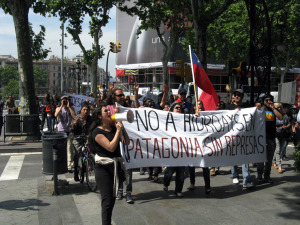Chile’s Controversial Energy Plan Rejected
On June 10 of 2014, the Chilean government cancelled development for a massive hydroelectric power system. The project, called HidroAysén, cost $8 billion and consisted of a series of five dams built across two rivers in Aysén, part of the Patagonia region in Southern Chile. The now defunct plan to increase energy production was largely supported by copper producers, who comprise a significant portion of the country’s economy. It was ultimately struck down, however, due to pressures from by environmentalists who were concerned about the detrimental effects that local ecosystem. The rejection of the project leaves uncertainties on whether Chile’s growing energy needs will be met.

The HidroAysén project has been the latest in a series of efforts to curb Chile’s dependence on foreign energy. The nation is naturally poor in oil and natural gas, and has to import 70% of its energy from others in the region. Argentina has historically been a main supplier of natural gas, but has been quick to cut Chile off as domestic demand has increased. A 19th century land dispute prevents Bolivia, another would-be supplier, from doing business with Chile.
This has left hydroelectric power as one of the best options for domestic energy. Chile currently produces 18 gigawatts of electricity across two principal grids; the Sistema Interconectado Central (SIC) and the Sistema Integrado del Norte Grande (SING). Together, this comprises about a third of Chile’s domestic energy production, much more than other more expensive sources like coal. Still, current production of hydroelectric power is not meeting demand and overall energy costs continue to rise rapidly. These costs have hit the vital copper industry especially hard, as it consumes some 35% of all the nation’s energy.
It was with these concerns in mind that Endesa Chile and Colbun, the two largest generators in the country, collaborated to create the HidroAysén project. The project would have added 2,750 megawatts to the national grid, and provided for 15-20% of the country’s needs. But in order to do this, five dams would be built across the Baker and Pascua rivers, flooding 5,900 hectares of the land in Aysén, potentially disrupting the area’s ecosystem.
Environmentalist groups strongly objected to the construction of the dams, because of the destruction they would bring to an area of Chile that has remained notably pristine and undeveloped. The dams, environmentalists argued, would threaten fragile ecosystems, indigenous culture, and the ecotourism industry. Additionally, the transmission line necessary to bring energy from Aysén to the capital city Santiago, would require the deforestation of stretches of the Patagonia forest. In essence, opponents of HidroAysén felt that the additional energy produced would have benefited the copper industry far more than the Chilean people.
While the project has been a point of political contention since its initial approval in 2011, citizens began to mobilize increasingly in past year. Groups such as the Patagonian Defense Council and Greenpeace Chile have led the charge and put increasing pressure on the government . Finally in June, the Chilean Committee of Ministers conducted its own review of the plan and decided to cancel the permit. Environment Minister Pablo Badenier called HidroAysén a “bad project” and stated that data on the potential environmental damages was not sufficient. The Patagonia Defense Council’s Executive Secretary Patricio Rodrigo has called the decision “the greatest triumph of the environmental movement in Chile.”
Currently, Endesa Chile and Colbún are in the process of appealing the HidroAysén decision. Observers have said that while a victory is not impossible, the companies now face significant legal challenges and will likely have to alter the plan to make it more eco-friendly. Whether or not they succeed, Chile’s energy crisis remains unresolved in the immediate future. One of the only things that both sides — the environmentalists and the industrialists — seem to agree upon is the need for Chile to diversify its energy sources. Chilean President Michelle Bachelet has advocated for this diversification, with a particular focus on renewable energies such as wind, solar, and geothermal power. She has promised that by 2025, 45% of newly installed capacity will come from these non-traditional sources. As of 2011,these alternative sources made up only 3% of Chile’s energy, so there is certainly room to grow.
